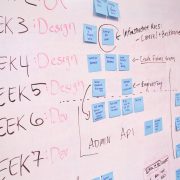Five Components to Building a Successful Training Program at Your Landscape Company
This article appeared in the September 2013 issue of Snow Business
 As long as you are an employer, you will deal with turnover, new hires and promotions. With this in mind, it’s to your benefit to promote a learning culture at your company. A great way to promote and reinforce a learning culture is to establish a training process. A training process not only helps with the day-to-day, but it also enhances your ability to scale and grow.
As long as you are an employer, you will deal with turnover, new hires and promotions. With this in mind, it’s to your benefit to promote a learning culture at your company. A great way to promote and reinforce a learning culture is to establish a training process. A training process not only helps with the day-to-day, but it also enhances your ability to scale and grow.
When I was at GroundMasters, we eventually set up a training university, a dedicated classroom in our building where we held meetings to cover anything that affected our staff, from HR to procedural changes, to education and training. It was very effective in helping us roll out new processes, get ideas from our team members and build company morale.
5 Components of a Rock Solid Training Process
No matter the size of your company, there are five major components to a successful training process. Put these components in place and you’ll have a winning program that will withstand the test of time.
Component One: Standard operating procedures
To get your training program off the ground, outline and document your Standard Operating Procedures (SOPs). These are all the things you need and expect your staff to know about the day-to-day operations. SOPs will be an ongoing, integral part of your training process. As your company changes and grows, your SOPs will, too. Revisit SOPs whenever necessary and make sure they are updated, known and understood.
Component Two: Choose a champion
In order for your staff to embrace the training process, you need to select a champion for the training program. This should be someone who will embrace the idea of standardized training. This person will also need to work well across departments and will likely lead the first few sessions. Once you get going, let the topic dictate who leads.
At GroundMasters, a variety of team members were involved in developing and leading our training sessions. If we were meeting about operations, a good, experienced production foreman would lead the session. If it was on a policy change or staff related, a branch manager would lead.
Since multiple people were involved, the responsibility for facilitating sessions was spread out, and as a result our training university wasn’t a burden to the staff members.
Component Three: Create a plan for topics
Start small and basic with training topics and expand as you figure out a format that works and topics your people respond to. Reviewing your SOPs and developing an orientation plan for new staff are good places to start. You may already have both items in place, even if they aren’t documented or planned in a strategic concept.
It’s also a good idea to divide topics among departments. It spreads the burden of getting a session together, particularly when getting started.
Invite a few key personnel to brainstorm topics and get the conversation started. Make sure you save all of the ideas that come out of the brainstorming session, even if you don’t think they will stand the test of time.
Component Four: Tap into your network
Your key personnel will be your best resources as to what your company is lacking and what would be most effective. Keep them involved and always encourage them to offer new ideas. These situations might provide an opportunity to get together for a session.
Tap into your network at SIMA and any other trade organizations you may be involved in. Your peers likely struggle with implementing training and staying on top of it, so they may offer some valuable solutions and insights as to how to start and maintain a program.
There are some great industry-related groups on LinkedIn you can join to ask the masses what they can offer and share as well.
Component Five: Choose a location
Ideally you want your training facility to be on-site. It’s a great benefit and will offer maximum flexibility and accessibility. Depending on the size of your facility, a dedicated space for training is great. A shared space like the confer-ence room or the warehouse works, too.
If your facility doesn’t allow for this, work off-site with a customer, hotel or some other space that you can easily and affordably use whenever needed. The important aspect is that the space is comfortable and conducive to learning.
The sooner you can establish a learning culture, the better off you’ll be. Plus, if you are planning to grow, I know no better way to operate than to establish a learning culture and a training process to back it up.









Leave a Reply
Want to join the discussion?Feel free to contribute!